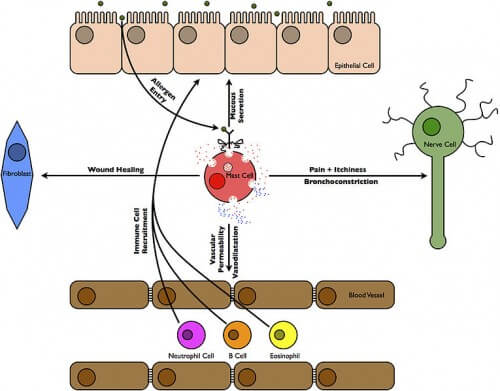Researchers have revealed how a synthetic molecule breaks down substances that cause an allergic reaction - a discovery that could lead to the development of effective and rapid treatments in the fight against a wide spectrum of acute allergic reactions

Researchers have revealed how a synthetic molecule breaks down substances that cause an allergic reaction - a discovery that could lead to the development of effective and fast treatments in the fight against a wide spectrum of acute allergic reactions.
The research, published online in the prestigious scientific journal Nature, was carried out by scientists from the Stanford University School of Medicine and the University of Bern in Switzerland.
The new inhibitor neutralizes IgE antibodies, substances that play a decisive role in the formation of acute allergies, by separating the antibody from its companion - a molecule known as FcR (a protein found on the surface of cells associated with the immune system).
"It would be an outstanding intervention if we could quickly turn off the IgE antibodies during an acute allergic reaction," said structural biology professor Ted Jardetzky, the study's principal investigator. It turned out that the inhibitor used by the research team works in exactly this way. Countless allergens (substances that trigger an allergic reaction in the body), starting from plant pollens, to bee stings and ending with nuts, may trigger the IgE antibodies, and these in turn cause an allergic reaction in just seconds. The new inhibitor breaks down the bond that binds these antibodies to the cells responsible for the allergic reaction, cells called mast cells (or mast cells; in English: Mast cells). The disruption of this link is the highlight of a successful treatment against an allergy triggered by IgE antibodies.
The first time an allergen enters the body, some people react by creating IgE antibodies specific to that specific allergen. These antibodies remain in the blood circulation long after the allergen has already been removed from the body. Most of these antibodies are disconnected from their activity by specific receptors for them, receptors called FcRs, which are on the outer surface of the mast cells. These mast cells are the first to be activated the next time the person is exposed to the same allergen.
Dissolving this coupling (IgE-FcR) has long been the target for the development of anti-allergy treatment, and for good reason: mast cells coated with IgE antibodies are a kind of grenade that is activated when the allergen re-enters the body. When the allergen "visits" the body again, it binds to the IgE antibodies found on the mast cells and causes the release of substances that cause inflammation - including the substance histamine - which accelerates the allergic reaction. As many people who suffer from allergies know this very well, these painful reactions occur within seconds. In situations of acute allergic reaction, the result may even be sudden death.
The key to actively neutralizing the immune response lies in the efficient breakdown of this coupling, but the chemical bonds between them are very strong. Today there is a drug on the commercial market (Xolair) that is able to prevent the reaction between the two coupling components, but it is not able to separate the two molecules after they attach to the surface of the fattening cells. That is, this drug can calm the allergic reaction, but its indication is not as a drug that can prevent sudden short attacks.
The research team discovered that a synthetic protein (DARPin E2-79) is able to detach the IgE antibodies from the surface of the mast cells. Through the use of this inhibitor, interactions that usually last several hours or even several days in terms of their stability, will be severed within seconds, explains the lead researcher.
The research group was able to decipher the structure of the inhibitory protein and use information about it to simulate its reaction with the IgE-FcR conjugate. In the next step, the researchers were able to follow in detail the stages of the link between the molecules and trace the mechanism it uses to break the bond between the two coupling components. With the help of the insights they received from these two stages, the researchers were able to identify a specific point where the attachment is weaker, a point where the inhibitor can focus in order to break the connection between them.
Despite the fact that this inhibitor is the first molecule to exhibit these dissociation properties, the researchers hope that this study will encourage the discovery of smaller molecules capable of acting in this manner even more efficiently. Researchers involved in drug development usually expect that large molecules such as the new inhibitor will be less effective than smaller molecules as inhibitors and that it is unlikely that they will be able to break down such complex conjugates, so the result itself was a complete surprise. Small molecules are more suitable for oral ingestion and are simpler and cheaper to manufacture than large molecules.

One response
Thank you very much for the information, I hope it really helps!
Is there an estimate for when the first medicine will be based on this?